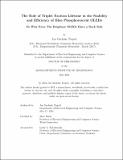The Role of Triplet Exciton Lifetime in the Stability and Efficiency of Blue Phosphorescent OLEDs Or Why Even The Brightest OLEDs Have a Dark Side
Author(s)
Tiepelt, Jan Onchoke
DownloadThesis PDF (68.82Mb)
Advisor
Baldo, Marc
Terms of use
Metadata
Show full item recordAbstract
Over the past decade, organic light-emitting devices (OLEDs) have evolved from emerging technology to dominating high-end mobile displays. Active-matrix OLED (AMOLED) displays offer superior color vibrancy, contrast, and form factor. Their thin, lightweight, and flexible nature holds promise for innovative form factors in smart- phones, wearables, and solid-state lighting, including curved, foldable, and rollable applications.
Amongst the greatest remaining challenges are the stability and loss of efficiency at high current densities, called roll-off, of blue high-efficiency OLEDs. After the discovery of fluorescent OLEDs by Tang and Van Slyke in 1987, exhibiting a mere 1% efficiency, Baldo et al. introduced highly-efficient phosphorescent OLEDs in 1998. This novel technology traded a quadrupling in efficiency for a significantly higher energy density stored in devices due to the existence of long-lived triplet excitons believed to be a crucial source of molecular damage and efficiency loss. Most modern AMOLED displays, to this day, employ high-efficiency phosphorescent OLEDs in red and green pixels, whereas blue emission is still realized by their much less efficient fluorescent counterparts owing to unacceptably low stability.
Countless architectural and chemical means have been explored to mitigate degradation phenomena in phosphorescent OLEDs. However, due to the interdependence of driving phenomena in OLEDs, the isolation of key parameters is highly-challenging and understanding of improvements is often merely empirical. As a consequence, key pa- rameters and the underlying physical mechanisms in the degradation and efficiency loss of phosphorescent OLED are not well understood and the existing challenges remain largely unresolved.
This thesis focuses on the role of triplet exciton lifetime in the stability and efficiency roll-off of blue phosphorescent OLEDs. We develop a toolbox of probing techniques that isolate triplet lifetime experimentally, that is, are ‘orthogonal’ to any other aspect of the device.
We follow a systematic approach of increasing complexity beginning with an optical system aiming at understanding fundamental stability behavior of archetypal phospho- rescent dye emitter systems. By engineering a plasmonic triplet quenching pathway, we find a cubic dependence of photostability on triplet lifetime for doped emitter sys- tems showing that triplet lifetime is a dominant factor - more so than reducing triplet density alone.
We then implement an ’orthogonal’ triplet lifetime isolation approach on OLEDs under operation that we coin external surface plasmon polariton modulation (SPPM). We reveal an only square-root dependence of OLED stability and roll-off on emissive triplet lifetime strongly suggesting that other excited state species may play a crucial role.
We combine SPPM with modulation of the emissive layer (EML) position to de- convolute the roles of charge carrier balance and triplet lifetime. We show that for a 15 nm shift of the EML the impact of charge carrier balance on both stability and roll-off exceeds that of triplet lifetime by a factor of three and four, respectively, highlighting the importance of the former in modern OLED design.
Using magnetic exciton annihilation modulation (MEAM) on phosphorescent OLEDS we show that non-emissive, ’dark’, excitons play a dominant role in efficiency roll-off and degradation. Dissociating dark triplets, we achieve a 2.5-times decrease in roll and degradation as well as a two-times increased dependence on bright triplet life- time. This key finding highlights the key role of typically overlooked dark excitons in phosphorescent OLED operation and in harnessing Purcell enhancement for device stabilization.
Finally, we explore device integration approaches, including extraordinary optical transmission through sub-wavelength hole arrays and transfer-printing of 2D arrays of plasmonic nanopatch antennas onto OLED stacks. Both aim at achieving high Purcell enhancement while maintaining a high device efficiency.
This thesis elucidates the intricate role of triplet exciton lifetime in the stability and efficiency of blue phosphorescent OLEDs. We gain unique insights from the developed in-situ characterization techniques highlighting the importance of deliberate strategies to manage dark triplet excitons in the quest to stabilize phosphorescent blue.
Date issued
2024-05Department
Massachusetts Institute of Technology. Department of Electrical Engineering and Computer SciencePublisher
Massachusetts Institute of Technology